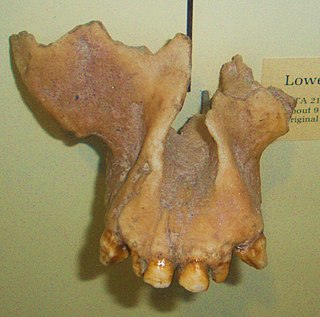 W
WAnkarapithecus is a genus of extinct ape. It was probably frugivorous, and would have weighed about 27 kilograms (60 lb). Its remains were found close to Ankara in central Turkey beginning in the 1950s. It lived during the Late Miocene and was similar to Sivapithecus.
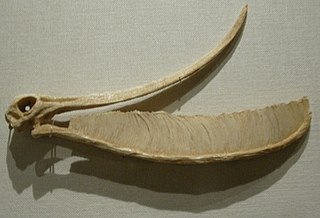 W
WArchaeopterodactyloidea is an extinct clade of pterodactyloid pterosaurs that lived from the middle Late Jurassic to the latest Early Cretaceous periods of Africa, Asia, Europe and North America. It was named by Alexander Wilhelm Armin Kellner in 1996 as the group that contains Germanodactylus, Pterodactylus, the Ctenochasmatidae and the Gallodactylidae. In 2003, Kellner defined the clade as a node-based taxon consisting of the last common ancestor of Pterodactylus, Ctenochasma and Gallodactylus and all its descendants. Although phylogenetic analyses that based on David Unwin's 2003 analysis do not recover monophyletic Archaeopterodactyloidea, phylogenetic analyses that based on Kellner's analyses, or the analyses of Brian Andres recover monophyletic Archaeopterodactyloidea at the base of the Pterodactyloidea.
 W
WBagaraatan is a genus of theropod dinosaur from the Late Cretaceous period. Its fossils were found in the Nemegt Formation of Mongolia. Bagaraatan may have been around 3 to 4 metres in length.
 W
WBlieckaspis priscillae is a pteraspidid heterostracan agnathan from the Middle Devonian of North America.
 W
WBurmomyrma is an extinct genus of ant-mimic wasp in the extinct family Falsiformicidae. The genus contains a single described species, Burmomyrma rossi. Burmomyrma is known from a single Middle Cretaceous fossil which was found in Asia.
 W
WDeltadromeus is a genus of theropod dinosaur from Northern Africa. It had long, unusually slender hind limbs for its size, suggesting that it was a swift runner. The skull is not known. One fossil specimen of a single species has been described, found in the Kem Kem Beds, which date to the mid Cretaceous Period, about 95 million years ago. It may be a junior synonym of the contemporary Bahariasaurus. Deltadromeus has often been considered a ceratosaurian, more specifically a member of the family Noasauridae. In 2016, a South American theropod known as Gualicho shinyae was found to possess many similarities with Deltadromeus. Depending on the phylogenetic position of Gualicho, Deltadromeus may have been a neovenatorid carnosaur, a tyrannosauroid, or a basal coelurosaur if its close relation to Gualicho is legitimate.
 W
WEcteninion is an extinct genus of meat-eating cynodonts that lived during the Late Triassic (Carnian) in South America. The type species Ecteninion lunensis was named by R.N. Martinez, C.L. May, and C.A. Forster in 1996. E. lunensis is known from a nearly complete skull of about 11 centimetres (4.3 in) in length. It was found in the Cancha de Bochas Member of the Ischigualasto Formation in the Ischigualasto-Villa Unión Basin in northwestern Argentina. It has been interpreted as a basal eucynodont. The holotype is in the collection of the Universidad Nacional de San Juan.
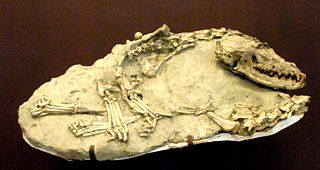 W
WEucyon is an extinct genus of medium omnivorous coyote-like canid that first appeared in North America during the Miocene, living from 10.3–3.6 Ma and existed for approximately 6.7 million years . The genus is notable because it is proposed that its lineage gave rise to the genus Canis.
 W
WGasparinisaura is a genus of herbivorous ornithopod dinosaur from the Late Cretaceous.
 W
WHaidomyrmex is an extinct genus of ants in the formicid subfamily Haidomyrmecinae, and is one of nine genera placed in the subfamily Haidomyrmecinae. The genus contains three described species Haidomyrmex cerberus, Haidomyrmex scimitarus, and Haidomyrmex zigrasi. All three are known from single Late Cretaceous fossils which have been found in Asia. H. cerberus is the type species and Haidomyrmex the type genus for the tribe Haidomyrmecini.
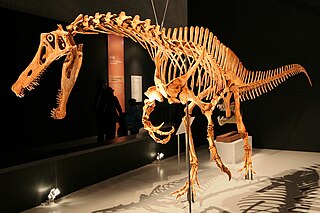 W
WIrritator is a genus of spinosaurid dinosaur that lived in what is now Brazil during the Albian stage of the Early Cretaceous Period, about 110 million years ago. It is known from a nearly complete skull found in the Romualdo Formation of the Araripe Basin. Fossil dealers had acquired this skull and illegally sold it to the State Museum of Natural History Stuttgart. In 1996, the specimen became the holotype of the type species Irritator challengeri. The genus name comes from the word "irritation", reflecting the feelings of paleontologists who found the skull had been heavily damaged and altered by the collectors. The species name is an homage to the fictional character Professor Challenger from Arthur Conan Doyle's novels.
 W
WMesodermochelys is an extinct genus of sea turtle known from the Campanian to the Maastrichtian of what today is Japan. One species is known, the type species M. undulatus; it was given its binomial name by Ren Hirayama and Tsutomu Chitoku in 1996. Studies of its skull indicate that it was a primitive member of the Dermochelyidae that was closely related to the Protostegidae. It has been described as the best representative of Mesozoic dermochelyids.
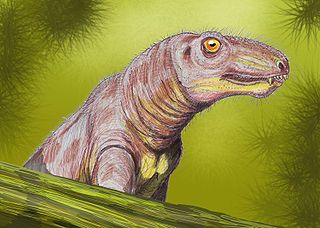 W
WMicrourania is an extinct genus of therapsids from the Middle Permian. It is known from a single partial skull found in the region of Orenburg, Russia.
 W
WMinicrania is an extinct genus of tiny antiarch fish, with armor averaging up to about 2 centimetres (0.79 in) long, which lived during the Lochkovian epoch in Early Devonian Yunnan Province, China and northern Vietnam.
 W
WNeovenator (nee-o-ven-a-tor), which means "new hunter", is a genus of allosauroid dinosaur. At the time of its discovery on the Isle of Wight, United Kingdom, it was the best-known large carnivorous dinosaur from the Early Cretaceous period of what is now Europe.
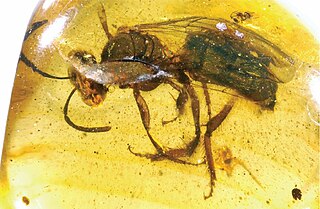 W
WOligochlora is an extinct genus of sweat bee in the Halictidae subfamily Halictinae. The genus currently contains six species, all of which are known from the early Miocene Burdigalian stage Dominican amber deposits on the island of Hispaniola.
 W
WPalaeophragmodictya is an extinct genus of sponge-grade organisms from the Ediacaran Period. Originally interpreted as a hexactinellid sponge, the organism also bears some coelomate characteristics, including bilateral symmetry.
 W
WParvicursor is a genus of tiny maniraptoran dinosaur with long slender legs for fast running. At only about 39 centimetres from snout to end of tail, and 162 grams in weight, it is one of the smallest non-avian dinosaurs known from an adult specimen.
 W
WPatagonykus is a genus of theropod dinosaur from the Upper Cretaceous of Argentina. This alvarezsaur was discovered in exposures of the Portezuelo Formation (Turonian-Coniacian) of the Rio Neuquén Subgroup in the Neuquén Basin, Neuquen Province of Patagonia, Argentina. The holotype consists of an incomplete but well-preserved skeleton, lacking a skull, but including many vertebrae, the coracoids, a partial forelimb, pelvic girdle, and hindlimbs. Patagonykus has been classed with the Alvarezsauridae, a family which includes such taxa as the Mongolian Mononykus and the Argentinian Alvarezsaurus. In 2010 Gregoy S. Paul estimated its length at 1 meter and its weight at 3.5 kg, while in 2016 Molina-Pérez and Larramendi gave a larger size of 2.8 meters and 30 kg.
 W
WPawpawsaurus, meaning "Pawpaw Lizard", is a nodosaurid ankylosaur from the Cretaceous of Tarrant County, Texas, discovered in May 1992. The only species yet assigned to this taxon, Pawpawsaurus campbelli, is based on a complete skull from the marine Paw Paw Formation.
 W
WPellegrinisaurus is a genus of titanosaurian sauropod dinosaur that lived in South America during the Late Cretaceous period. The holotype was found in the Allen Formation, Argentina.
 W
WPhosphatherium escuillei is a basal proboscidean that lived from the Late Paleocene to the early stages of the Ypresian age until the early Thanetian some 56 million years ago in North Africa. Research has suggested that Phosphatherium existed during the Eocene period.
 W
WPlesiopleurodon is an extinct genus of Mesozoic marine reptiles, belonging to Sauropterygia, known from the Late Cretaceous of North America. It was named by Kenneth Carpenter based on a complete skull with a mandible, cervical vertebra, and a coracoid. In naming the specimen, Carpenter noted "Of all known pliosaurs, Plesiopleurodon wellesi most closely resembles Liopleurodon ferox from the Oxfordian of Europe, hence the generic reference." It was initially described as a pliosaur due to it short neck, a common trait of the family, although it is in the order Plesiosauria. However, later exploration into the relationships of both orders indicate that not all pliosaurs have short necks and not all plesiosaurs have long necks.
 W
WPteranodontoidea is an extinct clade of ornithocheiroid pterosaurs from the Early to Late Cretaceous of Asia, Africa, Europe, North America and South America. It was named by Alexander Wilhelm Armin Kellner in 1996. In 2003, Kellner defined the clade as a node-based taxon consisting of the last common ancestor of Anhanguera, Pteranodon and all its descendants. The clade Ornithocheiroidea is sometimes considered to be the senior synonym of Pteranodontoidea, however it depends on its definition. Brian Andres in his analyses, converts Ornithocheiroidea using the definition of Kellner (2003) to avoid this synonymy.
 W
WSiamotyrannus is a genus of carnivorous theropod dinosaur from the early Cretaceous of Thailand.
 W
WSigilmassasaurus is a genus of spinosaurid dinosaur that lived approximately 100 to 94 million years ago during the middle of the Cretaceous Period in what is now northern Africa. Named in 1996 by Canadian paleontologist Dale Russell, it contains a single species, Sigilmassasaurus brevicollis. The identity of the genus has been debated by scientists, with some considering its fossils to represent material from the closely related species Spinosaurus aegyptiacus, while others have classified it as a separate taxon, forming the clade Spinosaurini with Spinosaurus as its sister taxon.
 W
WSinophoneus is an extinct genus of dinocephalian therapsids in the family Anteosauridae. A single fossilized skull has been found from the Middle Permian Xidagou Formation of China.
 W
WSinosauropteryx is a compsognathid dinosaur. Described in 1996, it was the first dinosaur taxon outside of Avialae to be found with evidence of feathers. It was covered with a coat of very simple filament-like feathers. Structures that indicate colouration have also been preserved in some of its feathers, which makes Sinosauropteryx the first non-avialian dinosaurs where colouration has been determined. The colouration includes a reddish and light banded tail. Some contention has arisen with an alternative interpretation of the filamentous impression as remains of collagen fibres, but this has not been widely accepted.
 W
WThalassiodracon (tha-LAS-ee-o-DRAY-kon) is an extinct genus of small pliosaurs. The type and only species, is Thalassiodracon hawkinsi Owen 1840.
 W
WUlemica is an extinct genus of venjukoviid therapsids. It was a basal member of the suborder Anomodontia that existed during the Middle Permian in Russia. The type species, U. invisa, was assigned to the genus Venjukovia prior to being placed within its own genus in 1996. This small anomonodont is only known from a partial skull.
 W
WVukhuclepis lyhaoensis is an extinct, primitive antiarch placoderm. Specimens are of mostly complete thoracic armor from the Early Devonian Lyhao Formation in Vietnam. The armor is very similar to that of Yunnanolepis, but is distinguished by a unique pattern of raised ridges radiating from a point at the center of the dorsal shield of the thoracic armor. A similar, albeit more floral-looking pattern is seen in the Chinese Mizia. V. lyhaoensis' armor is further ornamented with small tubercles.